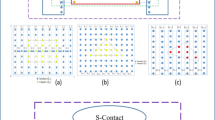Abstract
To include quantum effects, a quantum correction is made to the semi-classical Monte Carlo (MC) simulation by the effective conduction band edge (ECBE) method. The quantum corrected potential energy can be calculated from the classical potential energy by the ECBE equation and thus the quantum mechanical force in the simulation replaces the classical force. Under the non-equilibrium condition, carriers have a temperature different from the lattice. For the simulation of a double-gate MOSFET, we replace thermal energy in the ECBE equation with the average value of the stress tensor along each transverse line, to account for the variation of the electron “temperature” along the longitudinal direction. A 3 nm thick double gate nMOSFET is simulated. The result shows that electrons now see a higher barrier from the source to the drain if the carrier temperature is considered, resulting in a smaller drain current compared to that obtained from the previous ECBE method.
Similar content being viewed by others
References
T.-W. Tang and B. Wu, “Quantum corrected Monte Carlo simulation of semiconductor devices using the effective conduction-band edge method,” Comput. Electron, 2, 131 (2003).
B. Wu, T.-W. Tang, J. Nam, and J. Tsai, “Monte Carlo simulation of symmetric and asymmetric double-gate MOSFETs using bohm-based quantum correction,” IEEE trans. on nanotechnology, 2, 291 (2003).
T.-w. Tang and B. Wu, “Quantum correction for the Monte Carlo Simulation via Bohm, Wigner, and Effective Potentials,” Semiconductor Science and Technology, 19, 54 (2004).
T.-w. Tang, T. O’Regan, and B. Wu, “Thomas-Fermi approximation for a two-dimensional electron gas at low temperatures,” Journal of Applied Physics, 95, 7990 (2004).
B. Winstead, H. Truchiya, and U. Ravaioli, “Comparison of quantum corrections for Monte Carlo simulation,” Journal of Computational Electronics, 1, 201 (2002).
B. Winstead and U. Ravaioli, “A quantum correction based on Schrödinger equation applied to Monte Carlo device simulation,” IEEE trans. Electron Devices, 50, 440 (2003).
G.A. Kathawala, B. Winstead, and U. Ravaioli, “Monte Carlo simulation of double-gate MOSFETs,” IEEE trans. Electron Devices, 50, 2467 (2003).
Author information
Authors and Affiliations
Corresponding author
Rights and permissions
About this article
Cite this article
Wu, B., Tang, Tw. The Effective Conduction Band Edge Method of Quantum Correction to the Monte Carlo Device Simulation. J Comput Electron 3, 347–350 (2004). https://doi.org/10.1007/s10825-004-7074-5
Issue Date:
DOI: https://doi.org/10.1007/s10825-004-7074-5




